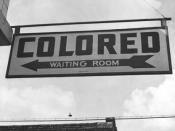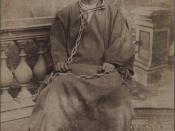The universal themes in "The Lesson" and "The Prisoner Who Wore Glasses", are appealing because their authors generate similar insights, despite structural and material differences in treatment. "The Lesson" draws attention to a what blacks have learned as children throughout their history in America; that each generation will suffer some degree of unequal opportunity and that each individual is empowered to effect the severity of that measure. The protagonist in "The Prisoner Who Wore Glasses", is strikingly remarkable mainly due to the fact that initially he is described quite feebly. It is through the story's development that he is later revealed to be durable, deep, and determined. These qualities enable him to successfully petition for humane treatment, in a racially oppressive climate, without begging the question of propriety.
Brille is a political prisoner in racially segregated South Africa, anyone would assume he joined politics to end apartheid.
Yet, in describing the unbelievable "human brutality" he has witnessed, he describes the fighting of his 12 children (21). Hannetjie assumed Brille was accustomed to Hannetjie's oppressive behaviors, but ironically Brille was only now a victim of violence (21). He did not use politics to better his life, until he was imprisoned for only pretending to do so before (23). Brille likens his experience in prison to his experience with his family, he becomes aware of his power to make others behave humanely. Brille's physical shortsightedness is symbolic of a mental shortsightedness, he that it will be more effective to punish Hannetjie's poor behavior like a child. Hannetjie is initially described as inhuman, and his reform by blackmail resulted in him not doing a proper job. Nevertheless, his evoked interpretation of humanity touched surprisingly and sincerely (53).
Sylvia's reactions to seeing a lady on Fifth Avenue in a fur coat, " . . . as hot as it is ", is characteristic of her ideals. She comments, "White folks crazy " in her surmised observation and limited insight (5). Window shopping at F.A.O. Schwartz, Sylvia and her companions are amused and flabbergasted at the prices of things they have no appreciation for; they are outraged at the prices for things they have gotten more cheaply. Sylvia assumes she knows what money is because she can steal it easily enough, she has trouble, though, dealing with the fact that people have money for things she doesn't know enough about to want (2) & (3). She realizes that she lives very differently from the "crazy people" who can afford them. Sylvia's later enlightenment is foreshadowed in describing herself and Sugar as "surly, . . .one of Miss Moore's words" (2). Evident influence is compounded when she decides to spend some time to think the day and her lesson through (55).
It is interesting to watch the protagonist in "The Lesson" bear similarity to the antagonist in "The Prisoner Who Wore Glasses". Sylvia and Hannetjie, both use condescension to elevate themselves and avoid questioning their own purpose and capacity. Brille, as the protagonist can be likened to Miss Moore, Sylvia's antagonist. He and she both optimize hard-learned lessons (both focused on what children must learn in order to survive & achieve potential) in drawing the best from others in order to better their communities. Ironically, they do this by pushing their pupils' capacity to comprehend to the limit. They also stress the importance of working for opportunities where they exist, and the personal understanding necessary to create these chances. Sylvia's and Hannetjie's reactions to their "teachers" both seem to imply, it is necessary to know your place in life in marking your goals and it is necessary to know your goals in applying your motives.





